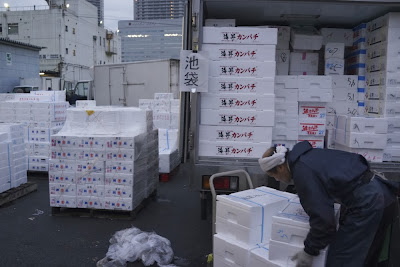The Tokyo Metropolitan Central Wholesale Market (東京都中央卸売市場 Tōkyō-to Chūō Oroshiuri Shijō), commonly known as the Tsukiji Market (築地市場 Tsukiji shijō), is the biggest wholesale fish and seafood market in the world and also one of the largest wholesale food markets of any kind (most of text is from Wikipedia)
4am departure from hotel to view the market
The market handles more than 400 different types of seafood from cheap seaweed to the most expensive caviar, and from tiny sardines to 300 kg tuna and controversial whale species.[3] Overall, more than 700,000 metric tons of seafood are handled every year at the three seafood markets in Tokyo, with a total value in excess of 600 billion yen (approximately 5.9 billion US dollars on November 24th, 2013). The number of registered employees as of 25 January 2010 varies from 60,000 to 65,000, including wholesalers, accountants, auctioneers, company officials, and distributors.
The auctions start around 5:20 a.m. Bidding can only be done by licensed participants.
These bidders include intermediate wholesalers (nakaoroshi gyōsha) who operate stalls in the marketplace and other licensed buyers who are agents for restaurants, food processing companies, and large retailers.
market from above
The auctions usually end around 7:00 a.m. Afterward, the purchased fish is either loaded onto trucks to be shipped to the next destination or on small carts and moved to the many shops inside the market. There the shop owners cut and prepare the products for retail. In case of large fish, for example tuna and swordfish, cutting and preparation is elaborate. Frozen tuna and swordfish are often cut with large band saws, and fresh tuna is carved with extremely long knives (some well over a meter in length) called oroshi-hōchō, maguro-bōchō, or hanchō-hōchō.
processing tuna / slips of paper above are orders from restaurants



















































.jpg)
















